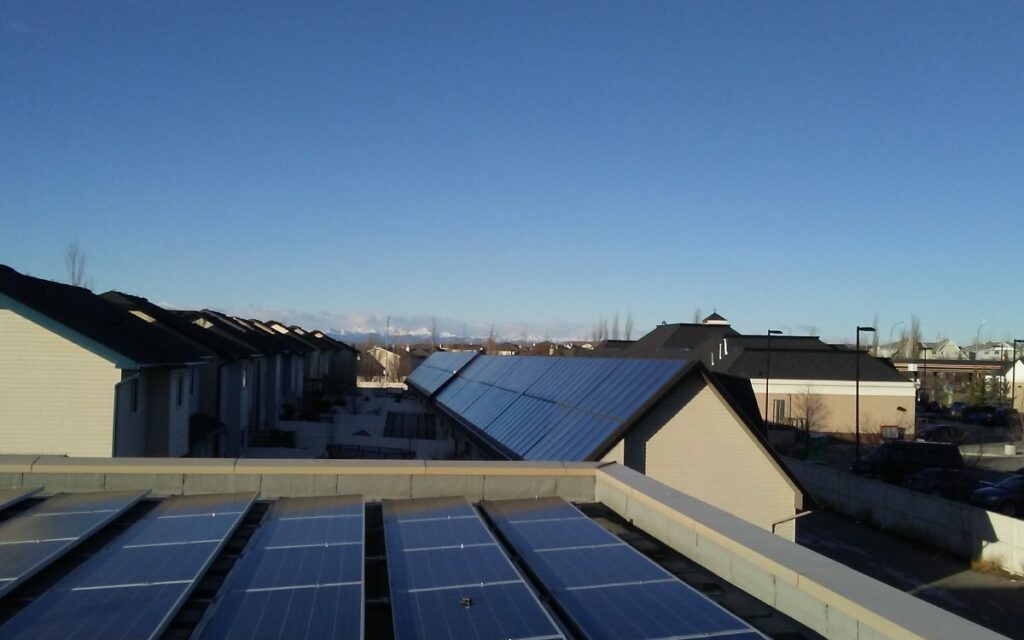
Photo Credit: Drake Landing
Back in 2007, a small community in Alberta called Drake Landing was built and was totally powered by solar energy. Energy from 800 solar panels located on garage roofs powered the 52 homes in the subdivision. Many of the residents were initially attracted by the notion that the community was powered by alternative energy and the fact it would be less expensive than fossil fuels. Over the years, Drake Landing has won a number of prestigious energy awards for being the first community in North America powered almost exclusively by solar energy.
However, all is not rosy these days in Drake Landing. After less than 20 years in operation, the solar energy system is starting to fail and the community faces some difficult decisions. The oversight body involved, the Drake Landing Company, has for some time been trying to find a reliable solution once the system failures were first detected and has said it will reach some type of solution before next winter.
Most residents would favour replacing the solar panels. The problem with that is changes in solar panel technology mean getting the necessary parts and people with the ability to install them into old technology is virtually impossible. A lack of funding to revamp the system is also an issue. There has been talk about replacing the solar energy system with natural gas, but that is largely unacceptable to the residents, most of whom chose to live there because of the solar power feature. Even if the residents agreed, there are issues with installing natural gas into homes that were designed to be heated by solar power. Apparently, some homeowners have already given in and converted to natural gas, concerned about a breakdown in the existing system.
What is surprising is that an eventual system failure did not seem to be planned for sufficiently. Regular furnaces typically need replacing about every 20 years and the same should be expected of alternate energy systems. The key question for Drake Landing residents is who will be paying for whatever replacement system is ultimately chosen. A number of residents think governments should step in and pay for the replacement, but its hardly fair for taxpayers to subsidize these homeowners when everyone else must pay for upgrades and replacements to their own homes without government help.
A common element of virtually all of the green energy projects is an optimism that often obscures practicality. Positive aspects are emphasized and downsides are not adequately acknowledged. Many billions of tax dollars have already been spent in Canada on these types of projects, most of which have not turned out to be particularly successful. It’s probably good to see the limits of the Drake Landing project now so that its problems can be avoided or at least reduced in future, but it is hard to believe they weren’t anticipated.
Canadians should also be concerned that we have been sold on many so-called green alternatives under false premises. Electric vehicles (EVs) are a good example. When Canadians were first encouraged to buy EVs and our tax dollars were used to subsidize their purchase there was little discussion of the fact that the charging infrastructure was so inadequate. The many negatives about EVs were not discussed, such as the higher likelihood of batteries combusting, heavier EV vehicles being harder on roads and making auto accidents worse, limited driving range and the very high replacement cost of batteries, among others.
The unrealistic sales job undertaken largely by governments did succeed in some people purchasing EVs, only to regret it later. As we have recently seen, demand has dropped off sharply as the negatives become better known. These details should have been understood at the outset. The same can be said for solar and wind energy, which has often proven to be impractical and even risky, and is certainly not a reliable replacement for other energy sources. Yet most if not all of the environmental advocates irresponsibly pretend we can eliminate fossil fuels entirely without difficulty. The federal government sets deadlines on things like when internal combustion engine vehicles will no longer be available in Canada, which is completely ridiculous and unrealistic.
The Drake Landing experience is not exactly a failure but more of a cautionary tale. In a large, cold country like Canada, we can’t take chances on people not having dependable heat and electricity. Technological change may improve non-fossil fuel energy sources in future but at present they need back up from natural gas or other reliable fuels. The consequences of not doing so are too serious to risk.

She has published numerous articles in journals, magazines & other media on issues such as free trade, finance, entrepreneurship & women business owners. Ms. Swift is a past President of the Empire Club of Canada, a former Director of the CD Howe Institute, the Canadian Youth Business Foundation, SOS Children’s Villages, past President of the International Small Business Congress and current Director of the Fraser Institute. She was cited in 2003 & 2012 as one of the most powerful women in Canada by the Women’s Executive Network & is a recipient of the Queen’s Silver & Gold Jubilee medals.




















